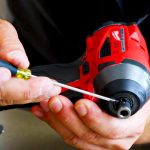Table of Contents
To get a brief idea about each tool, first, you need to know what each one is made of.
First, a grinder is a handy tool that you can use to straighten rough edges and surfaces. It has a high-speed motor running to drive a disc on the top. This disc is made of a composite material like aluminum, ceramic, silicon, or diamond grain. With a higher RPM, the disc grazes on the metal and flattens the surface. It can cut any metal object like a circular saw. And there are a variety of grinders such as angular grinders, bench grinders, die grinders, belt grinders, and so on.
On the other hand, a sander is operated through a similar high-speed motor. Still, it’s used to smoothen the wooden surface and remove the damaged color or stain from the wood by using a sandpaper disc rotating on the top of the motor. Also, it can come in variants like a belt sander, orbit sander, roller sander, etc.
Therefore, the main reason people cannot differentiate grinders and sanders for their looks. Significantly, the angular grinder and sander can be called twins. But, even after having the same design components inside, they have their level and places of work.
Work Materials
A grinder is required to cut metal bars, pipes, rods, tiles, etc. That means it directly works with the most rigid materials. If you have to polish your metallic tools, railings, frames, etc., none can do the job reliably like a grinder. Using it, you can remove old paints and clean up the rust to have a shiny output.
A sander is needed to remove stains and paints from wooden materials, besides making it smooth and polished. It helps in rounding the edges so that you don’t cut your hands accidentally by sliding your hands on the corner. So, depending on the materials you are working with, you should pick your perfect tool.
Work Precision
The grinder works with metals, and it is made of a solid and rugged disc to endure extreme impact and excessive heat. So, if you have durable objects, you can use a grinder so that the product cannot break apart. Though you can use both an angular grinder and a sander to polish things, a sander will deliver a more gentle performance. Especially when it comes to avoiding unconscious hits on metal things, a sander could do your job more precisely like a multi-tasker. But unlike it, a grinder cannot perform well on a wooden surface. Hence it will cut through with no control.
Work Safety
A grinder is used to straighten more rigid surfaces, and you need to hold it firmly. Otherwise, it could slip off and cut through your hands. Each time you work with it, wear thick clothes and gloves as it sparks. Specially designed helmets are a must to protect your eyes during work time. If you are a construction worker, the tool suits you. But in DIY and home works, this is dangerous.
On that, a sander runs with lower RPM and soft sandpapers. As a result, you have to protect your eyes and nose from dust by wearing a mask. Also, wearing gloves can keep your hands safe from abrasion, though there are very few reports of accidents while using them. It is safe to use in both the home and the workshop.
Work Versatility
Grinders and sanders are different, and sometimes one can take another’s place for their ability. For example, if you have to provide final polishing to any metal or wood, a sander can do that efficiently. Also, it can pull out old paint and rust reliably to get your job done. If you have a task that needs both cutting and polishing, a grinder can save you money as it can cut through metals. So, having a grinder is also beneficial, especially in plumbing work.
Conclusion
These are the critical aspects of a grinder and sander, which explains each of them having proper circumstances. While deciding on your tool, consider what types of work you will do. As a result, your pick will offer excellent value for your money, usage & productivity.










Leave a Comment